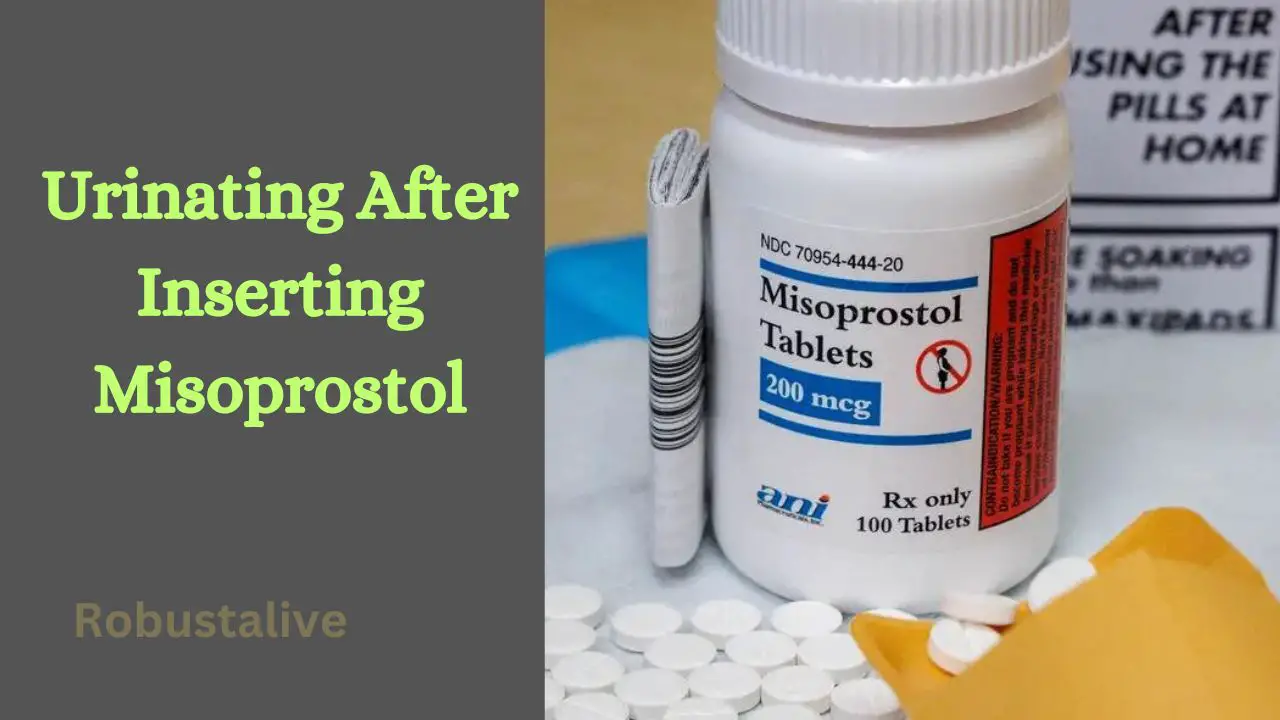Urinating After Inserting Misoprostol

Misoprostol is used for various things, from treating stomach issues to inducing labor. Moreover, these synthetic prostaglandin medications are used in treating postpartum bleeding. Also, it treats stomach ulcers and cervical ripening. However, confusion arises if a patient faces any problem urinating after inserting Misoprostol.
When someone inserts a radioprotective agent like Misoprostol, he may face difficulties while urinating. It happens due to loss of bladder control, urinary retention, pain, dyssynergia, bladder contraction, and urethral resistance deficiency. On the contrary, urinating right after inserting the medication, there will be a chance that the medication will exit with the pee.
In this article, we’ll discuss the causes of urination problems, and how to deal with problems that medications cause. Again, we will try to explain how to make medications work without causing pain or other problems.
Why is Urinating Difficult after Inserting Misoprostol?
Unfortunately, you may face difficulties after inserting Misoprostol. Whether taken orally or vaginally, these medications affect the bladder and urethra. Consequently, bladder pain, urinary incontinence, and urinary retention occur. However, the medications relax the urethra and cause stress incontinence.
From below, you may know why urinating difficulties happen, including,
- Loss of bladder control: One of the purposes of Misoprostol is to relax the urethra, which causes stress incontinence. Pelvic floor muscles and the urethral sphincter control urination. Through the medicine, the muscles and urethra become weak or even damaged. That results in loss of bladder control and then urination difficulties one may experience.
- Urethral resistance deficiency: When sympathetic tones decrease, urethral resistance lowers during urination. On the other hand, cholinergic parasympathetic tone increases, and bladder contraction happens. However, urine flows when bladder pressure is more significant than urethral resistance. But due to this, the process of urethral resistance is hampered. According to a National Library of Medicine study, Misoprostol causes urethral resistance deficiency. That results in urinary incontinence and difficulty urinating.
- Urinary retention: Misoprostol causes urinary retention. Due to retention, more chronic urination leads to excess urination. This is how urine volume increases drastically. Finally results in overflow incontinence, incomplete emptying of the Bladder, and difficulty urinating.
- Bladder pain: Hemorrhagic cystitis and urinary issues like bladder pain are connected to this certain medication. According to studies, vaginal Misoprostol relieves postmenopausal pain better than uterine straightening. However, urinary incontinence is brought on by a lack of urethral resistance. And finally, cause bladder pain.
- Dyssynergic bladder contraction: Dyssynergic bladder contraction is caused by these medications. Misoprostol in Arthrotec causes dyssynergia bladder contraction and leads to dyslexia. A condition known as dyssynergia causes bladder contractions. It causes the Bladder to tighten at the wrong time, making it difficult to urinate. Unfortunately, it leads to autonomic dysreflexia.
Symptoms of Difficulty in Urinating After Inserting Misoprostol
The body takes time to adjust to misoprostol medications. Inserting it causes diarrhea, nausea, and stomach cramps. Apart from these, facing difficulties while urinating is the most common problem. The symptom of urinating issues include
- discomfort or pain when urinating
- weak or sluggish urine flow
- The Bladder cannot be fully emptied.
- often urinating
- Urine with blood in it
- discomfort or pain in the abdomen
What Are The Side Effects of Misoprostol?
We already know how Misoprostol affects the bladder. Apart from that,
Here is a list of common side effects of this:
- Diarrhea
- Stomach pain
- Nausea
- Vomiting
- Constipation
- Indigestion
- Headache
- Upset stomach
- Gas
- Abdominal pain
- Hyperthermia
- Bladder pain
- Bloody or cloudy urine
- Bloody or black, tarry stools
- Blurred vision
- Body aches or pain
- Chest pain
- Chills
- Dehydration
- Dizziness
- Confusion
- Less urination
Immediate effects of inserting this radioprotective agent are nausea, bleeding, stomach cramps, and urination issues. These take a few days to disappear, especially stomach cramps. But diarrhea appears two weeks after the insertion and lasts one week.
Treatment Options for Difficulty in Urinating After Inserting Misoprostol
Here are some treatment options for difficulty in urinating after inserting Misoprostol:
Catheterization: Due to the use of this medication, you may face urinary retention. That means your urinary tract system will fail to empty the bladder, which can be solved by catheterization. This method will help you empty your Bladder.
Medication: Antimuscarinics or anticholinergics are used to relax the muscles in the Bladder and urethra. Antimuscarinics relax the bladder and urethra muscles by blocking acetylcholine. Acetylcholine is a neurotransmitter that is involved in muscle contractions.
Pain relief: Misoprostol causes the production of hormone-like substances, prostaglandins. These substances cause pain and inflammation. Medicine like Ibuprofen inhibits the production of these substances and alleviates bladder pain.
Fluid intake: Several bacteria cause urinary tract infections. Drinking plenty of fluids removes bacteria as well as prevents dehydration.
Bladder contraction solvation: When someone is suffering from dyssynergia bladder contraction, the bladder contracts at the wrong time. Henceforth, difficulty in urination one can experience. In that case, Propantheline bromide can treat bladder contractions.
Medical attention: You may experience severe pain, sustained fever, or other concerning symptoms after using Misoprostol. Then you should seek medical attention immediately
Relaxation Techniques to Get Rid of Urinating Difficulties Caused by Misoprostol
Relaxation techniques like kegel exercise and pelvic floor exercise help to get relief from urination difficulties. It works as follows,
- Help hold urine in the Bladder.
- Strengthen the Bladder
- Urge suppression techniques help you relax during a sudden urge to urinate and focus on relaxing other muscles.
- Deep breathing
- Therapy such as graduated exposure reduces anxiety and improves bladder control.
What Are Some Tips for Urinating After Inserting Misoprostol?
Maintaining some facts will help you get relief from difficulties during urinating while Misoprostol is inserted. Here we have shared some dos and don’ts for you:
Dos
- Use a heating pad to get rid of cramping.
- Consume over-the-counter medicine to avoid pain.
- Drink plenty of fluids.
Don’ts
- Take Misoprostol vaginally even though you are allergic to such medicines
- Use the medicine if you have a medical history of urinary surgery or a bleeding disorder
- Drink alcohol or use recreational medications while using the medication.
Frequently Asked Questions (FAQs)
How long does it take for the cervix to open after Misoprostol?
It takes 1-4 hours to start contractions after taking medicine like Cytotec. Within 24 hours, the blood, tissue, and fetus will all pass vaginally. After taking the second pill, about half of women will experience an abortion within four to five hours.
What to do after misoprostol insertion?
According to National Abortion Federation, after inserting the Misoprostol, you must lie down for about 30 minutes. The medicine sometimes comes out when bleeding starts or you move around. But do not worry if the pills fall out while you are bleeding. Most of the time, adequate amounts of the medication body absorbs. You can re-insert the tablets if they come out before the bleeding begins.
Can Misoprostol cause long-term urinary problems?
Though Misoprostol causes urinary problems, there is no evidence that it has a long-term effect. Fortunately, the patient suffers for a short period, and problems will disappear in 1-2 weeks with proper medications.
Conclusion
In conclusion, urinating after inserting Misoprostol is a common process. Hence, it will be better to urinate before inserting the medicine. However, some experience temporary discomfort or difficulty urinating, but no evidence exists that this radioprotective agent causes long-term urinary problems.
As with any medical procedure, It’s important to discuss or take advice from your healthcare provider. Seek medical attention immediately if you experience any concerning symptoms.





